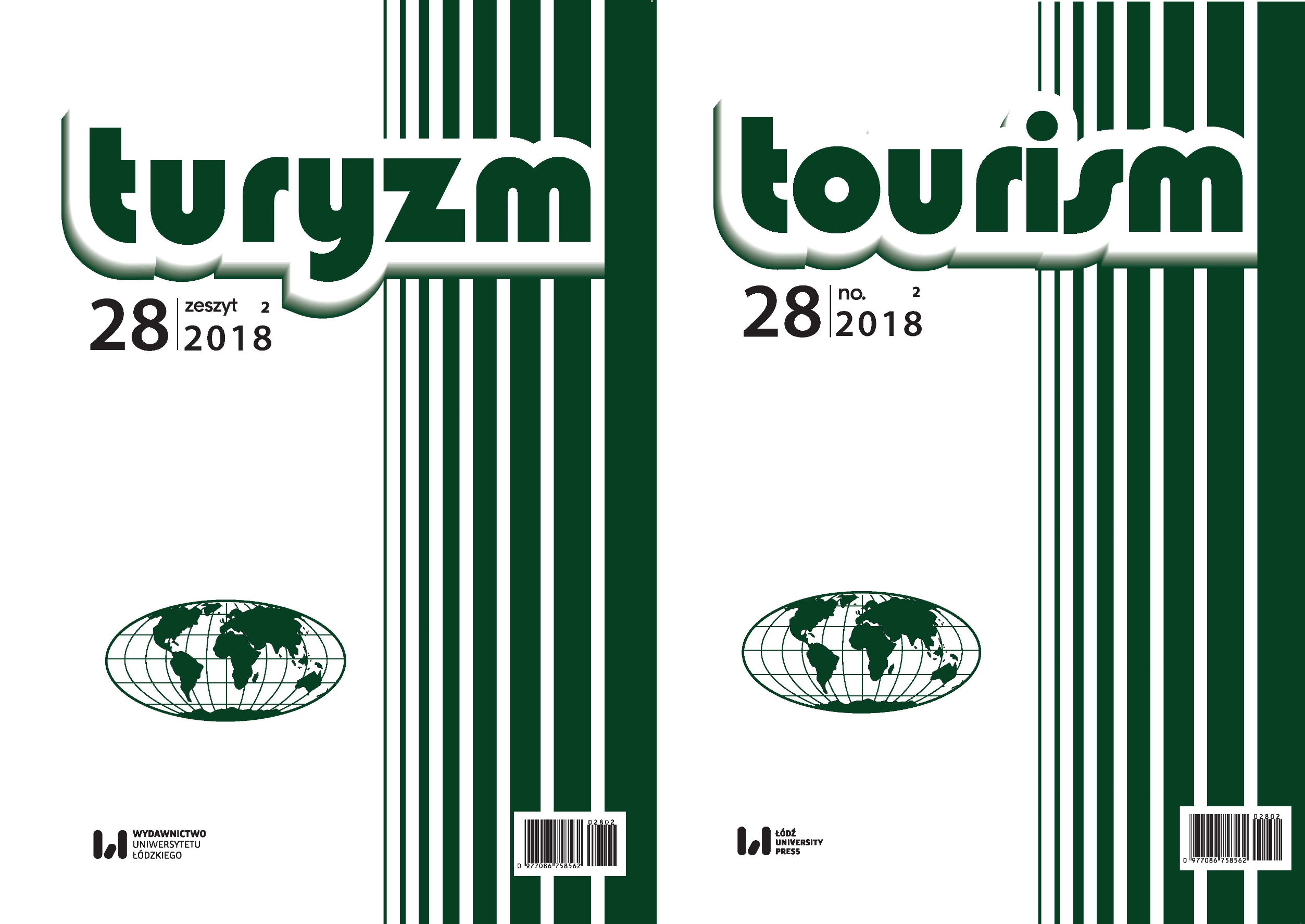Demolowanie i rewitalizacja w przestrzeni turystycznej Hawany
DOI:
https://doi.org/10.18778/0867-5856.28.2.01Keywords:
rewitalizacja, przestrzeń turystyczna, demolowanie, relacje społeczne, HawanaAbstract
Celem autorki artykułu jest analiza w ujęciu aksjologicznym procesów demolowania i rewitalizacji miejskiej przestrzeni turystycznej na przykładzie Hawany (Kuba) w kontekście relacji społecznych między turystami a mieszkańcami oraz ocena znaczenia zidentyfikowanych prawidłowości w przebiegu i skutkach tych procesów. W rezultacie analizy zidentyfikowano uwarunkowania demolowania przestrzeni turystycznej w Hawanie, czynniki egzo- i endogeniczne kształtujące ten proces, dwa typy rewitalizacji realizowanej jako działania naprawcze, a także wymieniono cechy relacji między mieszkańcami a turystami. Wyniki badań opatrzono autorskim komentarzem, wskazując elementy relacji społecznych, które powinny być brane pod uwagę przy realizacji procesu rewitalizacji miejskiej przestrzeni turystycznej, aby skutecznie ograniczać istniejące i potencjalne konflikty między mieszkańcami a turystami.
Downloads
References
AGARWAL S., SHAW G. (red.), 2007, Managing costal tourism resorts: A global perspective, Channel View Publications, [b.m.].
Google Scholar
BONIFACE B.G., COOPER CH., 2001, Worldwide destinations: The geography of travel and tourism, Elsevier, [b.m.].
Google Scholar
BOUJROUF S., TEBBAA Q. (red.), 2011, Tourisme et pauvreté, Editions des Archives Contemporaines, Paris.
Google Scholar
BUTLER R., 1980, The concept of a tourist area cycle of evolution: Implications for management of resources, „The Canadian Geographer”, 24, 1, s. 5–12.
Google Scholar
BUTLER R.W. (red.), 2006a, The tourism area life cycle, t. 1: Applications and modifications, Channel Viev Publications, Clevedon–Buffalo–Toronto.
Google Scholar
BUTLER R.W. (red.), 2006b, Tourism area life cycle, t. 2: Conceptual and theoretical issues, Channel Viev Publications, [b.m.].
Google Scholar
COLANTONIO A., POTTER R.B., 2006, Urban tourism and development of the socialist state: Havana during the „special period”, Ashgate, [b.m.].
Google Scholar
COOPER CH. i in., 2005, Tourism: Principles and practice, Pearson Education, [b.m.].
Google Scholar
DEWAILLY J.M., 1996, L'espace touristique: du réel au virtuel, 28é Congrés sur la Géographie, Haga.
Google Scholar
DEWAILLY J.M., PLAMENT E., 2000, Le tourisme, Campus Géographie, SEDES, [b.m.].
Google Scholar
HARRISON D., 2001, Tourism and the less developed world: Issues and case studies, Cabi Publishing, [b.m.].
Google Scholar
HENTHORNE T.L., 2018, Tourism in Cuba. Casinos, castros and challenges, Emerald Publishing Ltd., [b.m.].
Google Scholar
JOHNSON D.L., LEWIS L.A., 2007, Land degradation: Creation and destruction, Rowman & Littlefield Publishers, Lanham–Boulder–New York–Toronto–Oxford.
Google Scholar
JOHNSTON C.S., 2001, Shoring the foundations of the destination life cycle model. Part 1: Ontological and epistemological considerations, „Tourism Geographies”, 3, 1, s. 2–28.
Google Scholar
KACZMAREK S., 2001, Rewitalizacja terenów poprzemysłowych. Nowy wymiar w rozwoju miast, Wydawnictwo Uniwersytetu Łódzkiego, Łódź.
Google Scholar
KACZMAREK S., 2006, Urban tourism – the blessing or the curse, [w:] R.C. Lois Gonzáles (red.), Urban changes in different scales: systems and structures, Universidade de Santiago de Compostela, [b.m.], s. 361–368.
Google Scholar
KACZMAREK S., 2012, Kultura gospodarowania przestrzenią w mieście, „Studia Miejskie”, 5, s. 9–19.
Google Scholar
KACZMAREK S., 2015, Degradacja i rewitalizacja przestrzeni turystycznej. Refleksja teoretyczna, [w:] M. Durydiwka, K. Duda-Gromada (red.), Przestrzeń w turystyce. Znaczenie i wykorzystanie, Wydział Geografii i Studiów Regionalnych UW, Warszawa, s. 27–37.
Google Scholar
KACZMAREK S., 2017, Demolowanie jako radykalne narzędzie w procesie rewitalizacji, „Studia Miejskie”, 28, s. 9–20.
Google Scholar
KACZMAREK S., KOWALCZYK A., 2016, Rewitalizacja terenów poprzemysłowych i turystycznych, „Folia Turistica”, 41, s. 283–309.
Google Scholar
KERR R., 2009, The metamorphosis of Cuban architecture; development, decay and opportunity, University of Edinburgh, Edinburgh.
Google Scholar
PEÑARANDA CURRIE L., 2012, From colonial port to post-revolution: Urban planning for 21st century Havana, consilience, „The Journal of Sustainable Development”, 8, s. 50–69.
Google Scholar
REYNOLDS WOLFE L., 2000, Contesting the global restoration and neighborhood identity in Old Havana, http://lasa.international.pitt.edu/Lasa2000/ReynoldsWolfe.PDF; 21.07.2018.
Google Scholar
RYAN CH., 2003, Recreational tourism: Demands and impacts, Channel View Publications, Clevedon–Buffalo–Toronto–Sydney.
Google Scholar
SCHEYVENS R., 2002, Tourism for development: Empowering communities, Pearson Education, [b.m.].
Google Scholar
SMITH M., RICHARDS G., 2012, Routledge handbook of cultural tourism, Routledge, [b.m.].
Google Scholar
STAMM L., 2014, Deconstructing the dual city: preservation and tourism in La Habana Vieja, Senior Capstone Projects, Paper 385, Vassar College, Digital Window @ Vassar.
Google Scholar
VALLADARES A., 2018, The built environment in contemporary Old Havana: Building systems in a historic district, School of Urban Planning, McGill University, Montreal.
Google Scholar
WEAVER D., 2012, Sustainable tourism theory and practice, Routledge, [b.m.].
Google Scholar
WŁODARCZYK B., 2009, Przestrzeń turystyczna. Istota, koncepcje, determinanty rozwoju, Wydawnictwo Uniwersytetu Łódzkiego, Łódź.
Google Scholar
YIN R.K., 2014, Studium przypadku w badaniach naukowych. Projektowanie i metody, Wydawnictwo Uniwersytetu Jagiellońskiego, Kraków.
Google Scholar
Downloads
Published
How to Cite
Issue
Section
License

This work is licensed under a Creative Commons Attribution-NonCommercial-NoDerivatives 4.0 International License.










